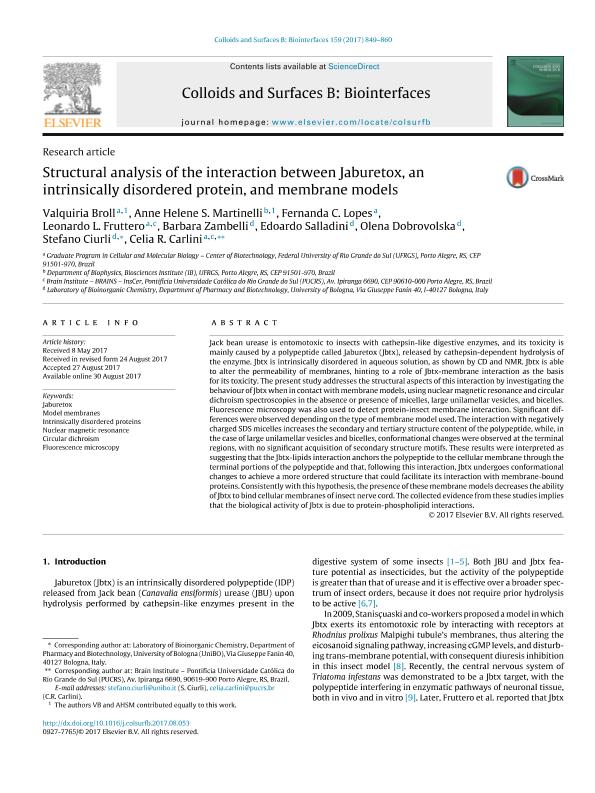Mostrar el registro sencillo del ítem
dc.contributor.author
Broll, Valquiria
dc.contributor.author
Martinelli, Anne Helene S.
dc.contributor.author
Lopes, Fernanda C.
dc.contributor.author
Fruttero, Leonardo Luis

dc.contributor.author
Zambelli, Barbara
dc.contributor.author
Salladini, Edoardo
dc.contributor.author
Dobrovolska, Olena
dc.contributor.author
Ciurli, Stefano
dc.contributor.author
Carlini, Célia Regina R S

dc.date.available
2018-08-13T14:46:39Z
dc.date.issued
2017-11
dc.identifier.citation
Broll, Valquiria; Martinelli, Anne Helene S.; Lopes, Fernanda C.; Fruttero, Leonardo Luis; Zambelli, Barbara; et al.; Structural Analysis of the Interaction between Jaburetox, an Intrinsically Disordered Protein, and Membrane Models; Elsevier Science; Colloids and Surfaces B: Biointerfaces; 159; 1; 11-2017; 849-860
dc.identifier.issn
0927-7765
dc.identifier.uri
http://hdl.handle.net/11336/55102
dc.description.abstract
Jack bean urease is entomotoxic to insects with cathepsin-like digestive enzymes, and its toxicity is mainly caused by a polypeptide called Jaburetox (Jbtx), released by cathepsin-dependent hydrolysis of the enzyme. Jbtx is intrinsically disordered in aqueous solution, as shown by CD and NMR. Jbtx is able to alter the permeability of membranes, hinting to a role of Jbtx-membrane interaction as the basis for its toxicity. The present study addresses the structural aspects of this interaction by investigating the behaviour of Jbtx when in contact with membrane models, using nuclear magnetic resonance and circular dichroism spectroscopies in the absence or presence of micelles, large unilamellar vesicles, and bicelles. Fluorescence microscopy was also used to detect protein-insect membrane interaction. Significant differences were observed depending on the type of membrane model used. The interaction with negatively charged SDS micelles increases the secondary and tertiary structure content of the polypeptide, while, in the case of large unilamellar vesicles and bicelles, conformational changes were observed at the terminal regions, with no significant acquisition of secondary structure motifs. These results were interpreted as suggesting that the Jbtx-lipids interaction anchors the polypeptide to the cellular membrane through the terminal portions of the polypeptide and that, following this interaction, Jbtx undergoes conformational changes to achieve a more ordered structure that could facilitate its interaction with membrane-bound proteins. Consistently with this hypothesis, the presence of these membrane models decreases the ability of Jbtx to bind cellular membranes of insect nerve cord. The collected evidence from these studies implies that the biological activity of Jbtx is due to protein-phospholipid interactions.
dc.format
application/pdf
dc.language.iso
eng
dc.publisher
Elsevier Science

dc.rights
info:eu-repo/semantics/openAccess
dc.rights.uri
https://creativecommons.org/licenses/by-nc-sa/2.5/ar/
dc.subject
Circular Dichroism
dc.subject
Fluorescence Microscopy
dc.subject
Intrinsically Disordered Proteins
dc.subject
Jaburetox
dc.subject
Model Membranes
dc.subject
Nuclear Magnetic Resonance
dc.subject.classification
Otras Ciencias Biológicas

dc.subject.classification
Ciencias Biológicas

dc.subject.classification
CIENCIAS NATURALES Y EXACTAS

dc.title
Structural Analysis of the Interaction between Jaburetox, an Intrinsically Disordered Protein, and Membrane Models
dc.type
info:eu-repo/semantics/article
dc.type
info:ar-repo/semantics/artículo
dc.type
info:eu-repo/semantics/publishedVersion
dc.date.updated
2018-08-08T18:17:39Z
dc.journal.volume
159
dc.journal.number
1
dc.journal.pagination
849-860
dc.journal.pais
Países Bajos

dc.description.fil
Fil: Broll, Valquiria. Universidade Federal do Rio Grande do Sul; Brasil
dc.description.fil
Fil: Martinelli, Anne Helene S.. Universidade Federal do Rio Grande do Sul; Brasil
dc.description.fil
Fil: Lopes, Fernanda C.. Universidade Federal do Rio Grande do Sul; Brasil
dc.description.fil
Fil: Fruttero, Leonardo Luis. Pontificia Universidade Católica do Rio Grande do Sul; Brasil. Consejo Nacional de Investigaciones Científicas y Técnicas. Centro Científico Tecnológico Córdoba. Centro de Investigaciones en Bioquímica Clínica e Inmunología; Argentina
dc.description.fil
Fil: Zambelli, Barbara. Universidad de Bologna; Italia
dc.description.fil
Fil: Salladini, Edoardo. Universidad de Bologna; Italia
dc.description.fil
Fil: Dobrovolska, Olena. Universidad de Bologna; Italia
dc.description.fil
Fil: Ciurli, Stefano. Universidad de Bologna; Italia
dc.description.fil
Fil: Carlini, Célia Regina R S. Pontificia Universidade Católica do Rio Grande do Sul; Brasil. Universidade Federal do Rio Grande do Sul; Brasil
dc.journal.title
Colloids and Surfaces B: Biointerfaces

dc.relation.alternativeid
info:eu-repo/semantics/altIdentifier/url/http://linkinghub.elsevier.com/retrieve/pii/S0927776517305696
dc.relation.alternativeid
info:eu-repo/semantics/altIdentifier/doi/http://dx.doi.org/10.1016/j.colsurfb.2017.08.053
Archivos asociados
